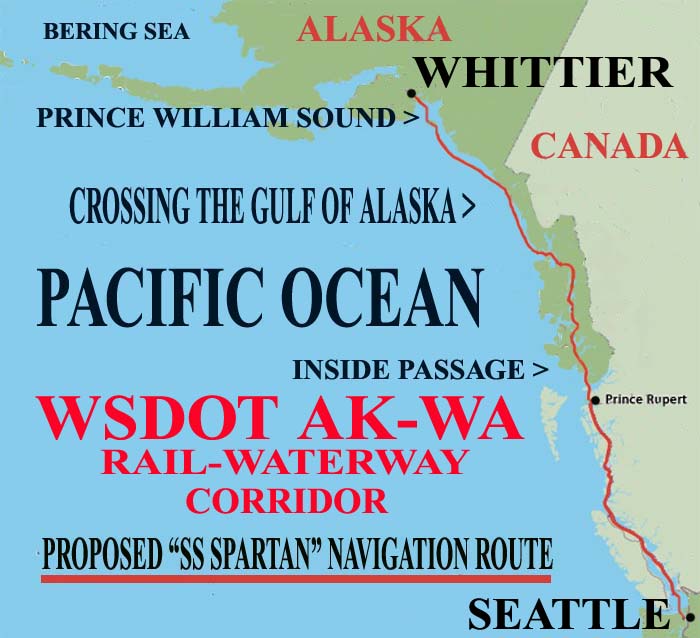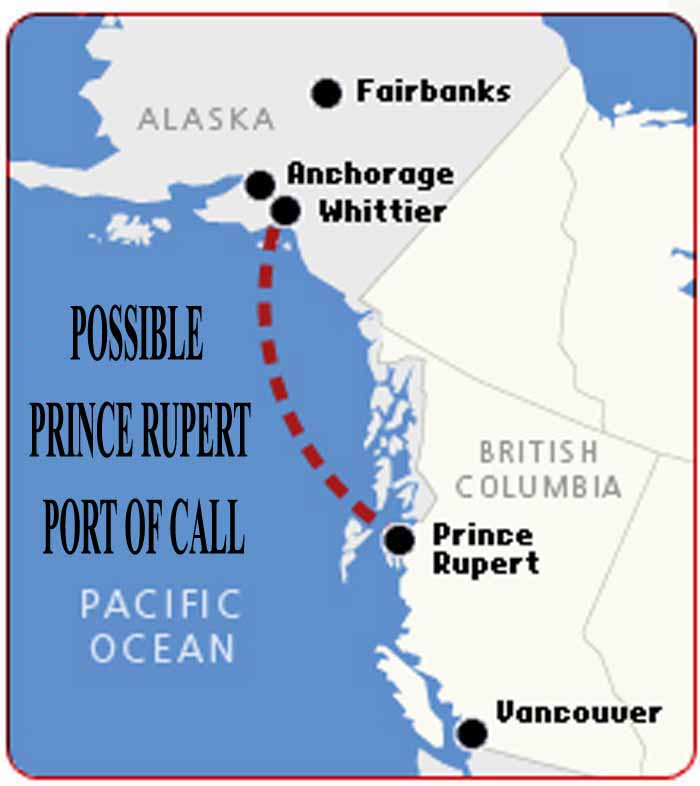Pacific Northwest Intermodal Rail and Port Facilities need solutions to remain competitive as an important component of a balance transportation supply system capacity, keeping cost in-controls, and sustainability concerns that warrant more transportation technology to be introduced to the market place. The concern for shippers is time and re-handle cargo, interchanging with different transportation systems, to turn profits in to assets and small inventory. Intermodal Rail requires better market forecasting and visibility, to control product demand flow, in advance to the supply demand
Having capacity to take advantages of short-waterway shipping corridors, which rail-carferries offer a seamless transition between interchange modes, thereby, quicker turn around, and less buffered inventory. But train carferries have yet to make the same impact that "barge services" have made in the Pacific Northwest and the reluctance of shippers to use high performance capacity of carferry technology, as other countries have been utilizing for a century. The Seattle Spartan Carferry Project has the means to turn-tide to this niche market.
The rail and port industry's must taking a direct interest and approach to carferry technology to update and inform traditional shippers, ATD LINES is taking a market approach to new strategies to introduce intermodal rail shippers to marine rail solutions.
Example: Mobile, Alabama, CG Railway, which has found a captive audience moving rail freight between the United States, Canada and Mexico's by waterway. Operating two freight class double deck, 115 railcars vessels, sailing’s every four days from Coatzacoalcos, Mexico, to Mobile, Alabama.
The Seattle, Washington to Whittier, Alaska, proposed project will utilizing the SS Spartan Class Carferry, as Washington-Alaska Waterway Corridor has a captive audience, that will provide express shipping and passenger services, targeting two major markets, as in freight and tourism opportunities.
Many of the marine routes that once provided carferry service, has lost the competitive edge over the year, do to have limited knowledge on emerging technologies and lack of understanding on how to re-develop marine rail service. Marine rail carferry service is a niche market for rail operation that can only operate to locations, where the rail service providers and shippers have a waterway corridor with major target market.
Example: SS Badger/Lake Michigan Carferry water corridor for domestic rail business between Manitowoc, Wisconsin and Ludington. Michigan is a market waiting to be re-developed. The niche market is "private railcar industry" which include operating museums, Amtrak specials and various rail association within private rail passenger industry, which are disadvantage towards access to marine rail service compared to the land routes.
In comparison, Washington-Alaska Waterway Corridor has a slow awkward domestic marine rail barge service, with restricting port opportunities and preventing tourism service in its practice and operations.
Marine rail carferry services can transport railcars containing bulk, packaged, liquid shipments and passenger trains, in which product volumes are distinguish between boxcars, hoppers, gondola, tank, flatbeds, double-stack containers, including single and superliner class passenger cars. Including the capacity to transport automobiles and trucks with in the same cargo decks of a ship.
There are many advantages of shipping with carferries in a combination of auto rail, marine and passenger, which provides a commitment opportunity toward "environmental greener objectives", which reduces over-the-road congestion and alternative route to traditional auto-rail land crossings and air.
Marine rail carferry shippers benefit from consistent “express” transportation services, efficient utilization of equipment and providing port-rail-passenger ship solutions, toward supply and demand requirements. The combination of rail and marine services provides the ability to load and transport a large volume of rail cargo that requires no rehandling. Rail shippers who utilize land-waterway corridors can reduce lead times, inventory levels, private freight car fleet reduction and increase in private railcar passenger rail line community tourism do to a continuous flow of beneficial rail traffic.
The SS SPARTAN/Pacific Coastal Carferry target markets focus on Washington-Alaska trade are within connecting scope of national long haul operations and port interchange to the Alaska Railroad connection via Seattle-Prince Rupert-Whittier ports of call at pier-48 provides direct interchange to 5 Class I-III railroads and the private passenger railcar industry, providing ship-rail interchanges to target rail line community markets.
The "Class I" long haul railroads serving the Port of Seattle, are:
Alaska Railroad
Burlington Northern Santa Fe
Canadian National
National Railroad Passenger Corporation
Union Pacific
The "Class II" shortline railroads serving the Washington State, are:
Ballard Terminal Railroad,
Blue Mountain Railroad,
Cascade and Columbia River Railroad,
Central Washington Railroad,
Columbia & Cowlitz Railway,
Columbia Basin Railroad,
Eastern Washington Gateway Railroad,
Great Northwest Railroad,
Kettle Falls International Railway,
Meeker Southern,
Montana Rail Link,
Mount Vernon Terminal Railway,
Palouse River & Coulee City,
Pend Oreille Valley Railroad,
Port of Chehalis,
Portland-Vancouver Junction Railroad,
Puget Sound & Pacific Railroad,
Royal Slope Line,
Tacoma Rail,
Tri-City & Olympia Railroad,
Washington and Idaho Railway,
White Swan Branch Line.
The "Class III" private freight carriers serving the Washington State, are:
Longview Switching,
Weyerhaeuser Woods Railroad,
Simpson Timber Railroad.
The "Class III" tourism railroads serving the Washington State, are:
Battle Ground, Yacolt and Chelatchie Prairie Railroad Association,
Chehalis–Centralia Railroad,
Chelatchie Prairie Railroad,
Lake Whatcom Railway,
Mt. Rainier Scenic Railroad,
Northwest Railway Museum,
Sound Transit Commuter Rail,
Yakima Electric Railway Museum,
Yakima Valley Rail and Steam Museum Association,
Yakima Valley Transportation.
The "Class III" Private passenger railcar and operating museums serving the Washington State, are:
American Association of Private Railcar Owners,
National Railroad Historical Society.
The railroads listed above and national interchange shippers would be Seatle-Whitter carferry customers.
Seattle SS Spartan Carferry Service at pier-48 would allow wide variety of railroads and shippers to compete in Washington-Alaska freight and tourism trade markets that in the past were not reachable because of long and slow barge interchange, high inventory costs, and/or high freight rates. Seattle Port and rail industry operating in Seattle Market has consistent monthly volume, which would provide additional transportation options to increase economic growth.
The Proposed SS Spartan carferry services, would be under railroad and maritime tariffs, including interchange rules, thereby participate in the railroads and marine carferry guidelines as if traveling throughout the entire national/international transportation system.
Marine rail carferry services may not be a solution in all regional waterway corridor situations, but can be effective where the market will allow expanding services and where marine tourism destination are a major market to recognize.
Louis AlloinSpartan Project Chairman




![Crossing Gate]](http://www.atdlines.com/motion/train6.gif)